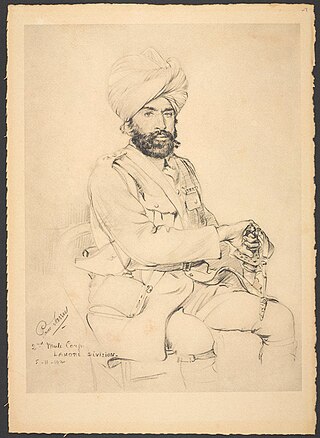Related Research Articles

The 10th (Irish) Division, was one of the first of Kitchener's New Army K1 Army Group divisions, authorized on 21 August 1914, after the outbreak of the Great War. It included battalions from the various provinces of Ireland. It was led by Irish General Bryan Mahon and fought at Gallipoli, Salonika and Palestine. It was the first of the Irish Divisions to take to the field and was the most travelled of the Irish formations. The division served as a formation of the United Kingdom's British Army during World War I.

The 12th (Eastern) Division was an infantry division raised by the British Army during the First World War from men volunteering for Kitchener's New Armies. The division saw service in the trenches of the Western Front from June 1915 to the end of the war.

The 61st Division was an infantry division of the British Army raised in 1915 during the Great War as a second-line reserve for the first-line battalions of the 48th Division. The division was sent to the Western Front in May 1916 and served there for the duration of the First World War.

The 60th Division was an infantry division of the British Army raised during the First World War. It was the second line-formation of the 47th Division, and was the second of two such Territorial Force divisions formed from the surplus of London recruits in 1914.
The 10th Indian Division was an infantry division of the British Indian Army during World War I. It was formed in Egypt in December 1914 with three infantry brigades of Indian Expeditionary Force F. After taking part in the Actions on the Suez Canal, the division was dispersed as its brigades were posted away.

The Indian Army, also called the British Indian Army, was involved in World War I as part of the British Empire. Almost 1.5 million Indian troops served overseas, of whom 62,000 died and another 67,000 were wounded. In total at least 74,187 Indian soldiers died during the war.

The 7th (Meerut) Division was an infantry division of the Indian Army and before 1895, the Bengal Army, that saw active service during World War I.

The 3rd (Lahore) Division was an infantry division of the Indian Army and before 1895, the Bengal Army, first organised in 1852. It saw service during World War I as part of the Indian Corps in France before being moved to the Middle East where it fought against troops of the Ottoman Empire.
The 5th (Mhow) Division was a regular division of the British Indian Army and part of the Southern Army which was formed in 1903 after Lord Kitchener was appointed Commander-in-Chief, India between 1902 and 1909. He instituted large-scale reforms, including merging the three armies of the Presidencies into a unified force and forming higher level formations, eight army divisions, and brigading Indian and British units. Following Kitchener's reforms, the British Indian Army was "the force recruited locally and permanently based in India, together with its expatriate British officers."
The Battle of Es Sinn was a World War I military engagement between Anglo-Indian and Ottoman forces.

The Battle of Sheikh Sa'ad occurred between 6–8 January 1916 during the Mesopotamian Campaign of the First World War. The battle took place along the banks of the Tigris River between the Anglo-Indian Tigris Corps and elements of the Ottoman Sixth Army. The engagement was the first in a series of assaults by the Tigris Corps to try to break through the Ottoman lines to relieve the besieged garrison at Kut.
The Rawalpindi Parade 1905 was a parade by the British Indian Army held in Rawalpindi on 8 December 1905 to honour the Prince and Princess of Wales. The troops were under the Command of Horatio Herbert, Viscount Kitchener of Khartoum, G.C.B., O.M., G.C.M.G., Commander-in-Chief India. The Royal party arrived at the parade ground escorted by a Field Officer's escort of 1st Skinner's Horse. They then received a Royal salute and inspected the troops, accompanied by the Commander-in-chief. On conclusion of the inspection, the troops on parade marched past in the following order.
The 34th Indian Brigade was an infantry brigade of the British Indian Army that saw active service in the Mesopotamian campaign in the Indian Army during the First World War. It was reformed for the Second World War as the 34th Indian States Forces Infantry Brigade.

This is an order of battle listing the Allied and Ottoman forces involved in the Gallipoli campaign during 1915.
The 2nd Home Counties Division was a 2nd Line Territorial Force division of the British Army in World War I. The division was formed as a duplicate of the 44th Division in November 1914. As the name suggests, the division recruited in the Home Counties, particularly Kent, Middlesex, Surrey and Sussex. In August 1915, in common with all Territorial Force divisions, it was numbered as 67th Division. Between September 1917 and the end of the year, the division was extensively reorganized and lost its territorial identity; henceforth it was known as 67th Division.
The 12th Indian Brigade was an infantry brigade of the British Indian Army that saw active service in the First World War. It served in the Mesopotamian Campaign on the Euphrates Front throughout its existence.
The 28th Indian Brigade was an infantry brigade of the British Indian Army that saw active service with the Indian Army during the First World War. Formed in October 1914, it defended the Suez Canal in early 1915, ended the Ottoman threat to Aden in July 1915, took part in the Mesopotamian Campaign in 1916 and 1917, before finishing the war in the Sinai and Palestine Campaign. It remained in Palestine until it was broken up in 1920.

The 1st Devonshire Artillery Volunteers and its successor units served in the British Army's Reserve Forces from 1859 to 1961. During World War I it carried out garrison duty in British India but went on to see active service in the Third Anglo-Afghan War. Converting to an air defence role before World War II its units participated in the Norwegian campaign and the Dunkirk evacuation, the Battle of Britain and then the campaigns in North Africa, Italy, and Burma

The II Wessex Brigade was a howitzer unit of the Royal Field Artillery in Britain's Territorial Force (TF) that was formed on the Isle of Wight in 1908. It served in India and the Middle East during World War I, one of its batteries being captured at the Siege of Kut in Mesopotamia in 1916, and another seeing active service in the Third Afghan War of 1919. Although reformed after the war, the unit was broken up in 1927.
The Structure of the Egyptian Expeditionary Force over the course of the First World War is shown below.
References
- ↑ Gardner 2004 , pp. 307–326
- 1 2 3 Perry 1993 , p. 78